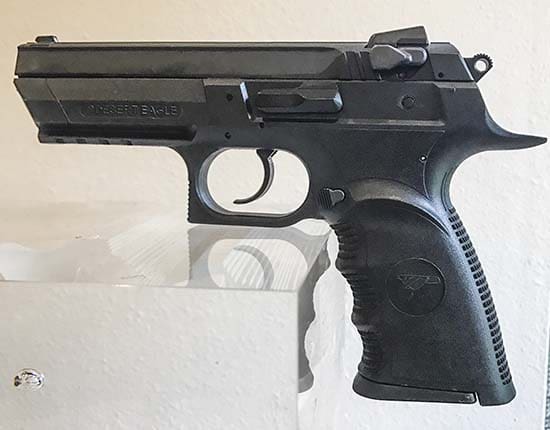
After a few years of unavailability in the U.S., Kahr Arms purchased Magnum Research and began reimporting the Baby Desert Eagle in 2011. This year, they’re extending the line with a downsized polymer gun that evokes the iconic big boy pistol famously chambered in . 50AE. With the new Baby Desert Eagle III, they’ve managed to tame the significant snap .40S&W in a gun that’s surprisingly fun to shoot.
In case you’re wondering, the Baby Desert Eagle III isn’t a scaled down version of the famous .50AE Desert Eagle. They may resemble each other, but the two pistols differ entirely in their function.

The Baby Desert Eagle is based on what is probably my most recommended handgun, the CZ 75. That design became the basis for the Israeli military’s the Jericho, which later moped into what became the Baby Desert Eagle. If you’re thinking the Baby Desert Eagle III is the Jericho, you’re close, but not they aren’t the same. There’s that polymer frame and the slide-mounted safety, just to name two big differences.
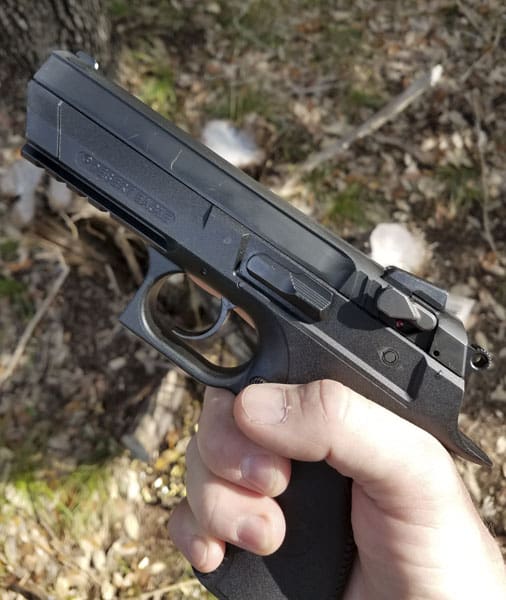
In terms of style, the polymer Baby Desert Eagle III is a bit of a chimera. The slide is large, steel, boxy…all angles and sharp lines. The top of the polymer frame follows those same lines, until you hit the grip, which is all swells and curves. The mixed materials add to the bipolar effect. But the lines flow into themselves and generally work. What also works is the slide to frame fit.
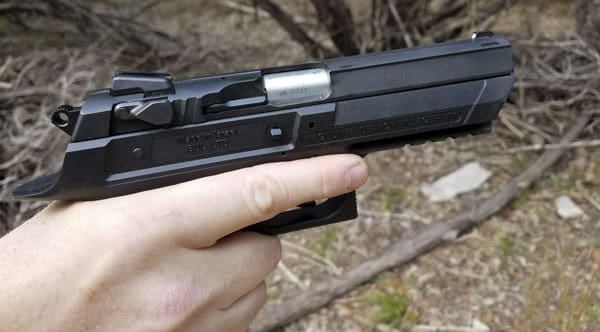
I don’t mean how tight it fights…that’s ok but nothing special, I mean how the slide fits inside of the frame. Although the gun appears to have a high bore axis, that’s misleading. About half of the barrel sits inside of the frame during function, and you can see with the action open how little of the slide actually rides above the frame rails.
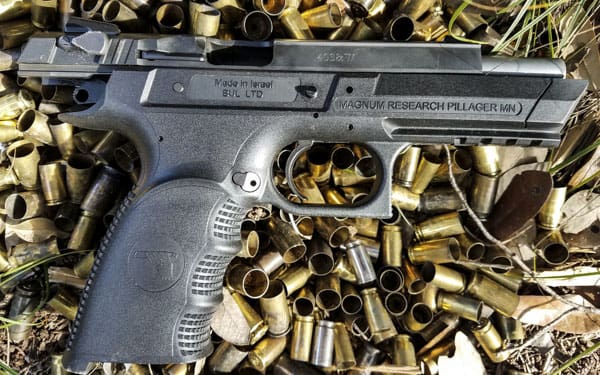
The result is visually interesting, but more importantly, highly functional as it brings all of that mass closer to your hand. That reduces felt recoil and muzzle rise. Also deciving is the size of the gun. Just looking at it, I’d have thought it was larger and heavier than it is. In fact, it’s a quarter of an inch shorter than, and 6oz less than the Beretta 92FS. A steel framed version is offered that is 9 oz heavier.

The sight set up is pretty standard, 3 big white dots. I would hope on a “tactical” minded pistols these would be fiber optic or Tritium for low light shooting, but that’s hard to get at this price point. I’m disappointed that the rear sight has a ramp front. I’d much prefer something like a Heine or other design with a grippy shelf that would allow me to cock the weapon one-handed against clothing, a boot, or my teeth (I’ve only had to do that once.)
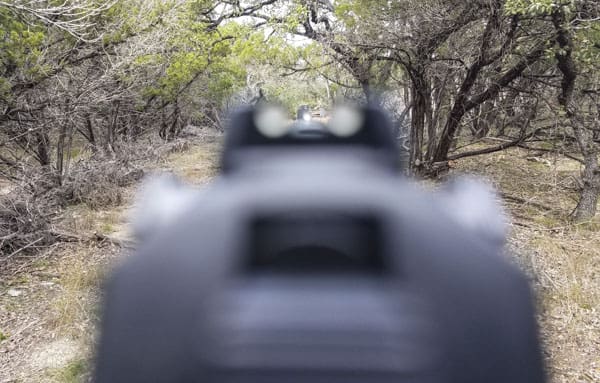
Although there’s space between the sights, its not so much that it has much of a negative effect on accuracy, and the gun has a lot of “pointability.” John Moses Browning’s influence really shows here. Although a now distant variation of the High Power, that same ability to go right up and point at the target is there with the Baby Desert Eagle.
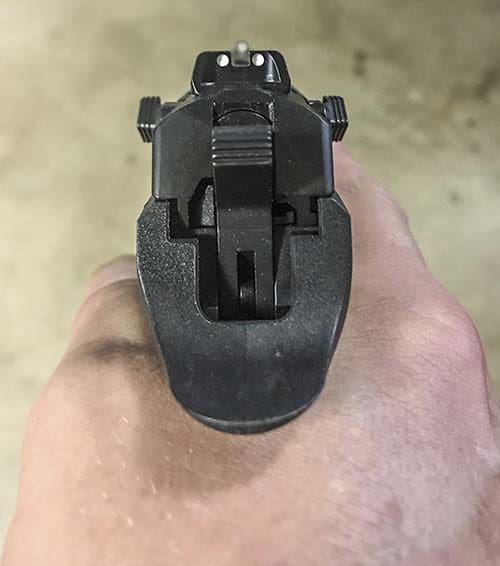
The grip is long, curved, and narrow, using a single stack magazine. Beyond just the shape, the front and back strap of the polymer framed grip are both heavily textured, with light finger groves molded in. There’s also an obvious and usefull shelf for your thumb that works well in single-handed fire as well as funneling your thumb to the magazine release. That release isn’t particularly obtrusive, but the layout of the grip works so well that my thumb went right to it when needed, and the two supplied factory magazines ejected with ease.
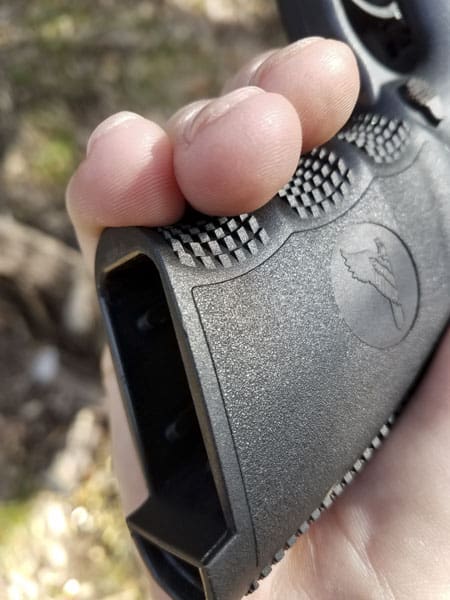
Reloading a magazine was not particularly difficult, but the magwell isn’t funneled in any way, and in fact has several sharp edges to catch a magazine. Disciplined practice solves the problem, but if you were hurt, bloody, and stupid from blood loss and trauma, it might catch up to you.
To put it bluntly, that slide-mounted safety is an abomination. Massive, rough in movement, and located in entirely the wrong place. It begs to get caught on things. It’s like they were trying to out do the Beretta 92FS in otherwise ruining a good thing. And they succeeded.
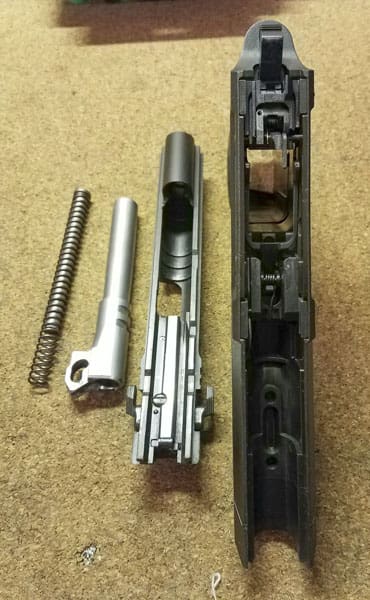
I tried clearing an induced stovepipe (and induced is the only way I could get them) by dropping the mag and racking the slide. Just like my old M9, if I did it fast without looking, I mistakenly reengaged the safety several times. Also like my old service pistol, I had to relearn to grip the slide forward of the ejection port to clear a malfunction, or just be willing to always press that safety forward every time, need it or not.
Those are your training options to get over what should be like the 92G. That is, this should be a decock only. That long double action first pull and a good holster is safety enough. This safety is also a decocker, returning the hammer to the full forward position.
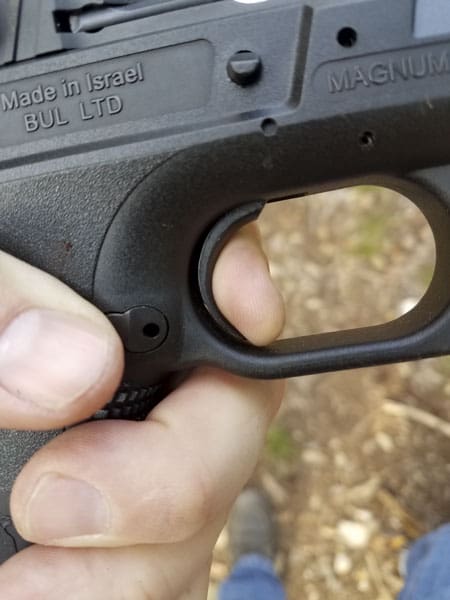
In single action, the trigger is OK, but in double action it doesn’t even rise to that middling level. In single action mode, the trigger is still too long, and breaks within a millimeter of the frame at around 4 1/2 lbs with little grit and one felt click during the pull, if you’re moving it really slowly. The double action trigger is heavy — 12 to 13 pounds — with a sharp stack right a the end.
Old-school revolver shooters won’t have a problem here, because they’ll allow their finger to slide down the trigger, “stroking” it. You should definitely follow their example. Failing to do so will result in a very sharp muzzle dip prior to that hammer falling. Of course, you then have the single action, where you won’t have to stroke it at all. I still struggle with that change on all my DA/SA guns, but the sharp stack of this model is a particular challenge.
As far as reliability, the Baby Desert Eagle is wonderfully, boringly perfect. I put 500 rounds of mixed ammunition through the Baby Deagle with no malfunctions of any kind. It sometimes looks as if it hasn’t fully locked back on an empty magazine, and there were a couple of times that fooled me. But it’s just the particular geometry of the gun. It performed flawlessly.
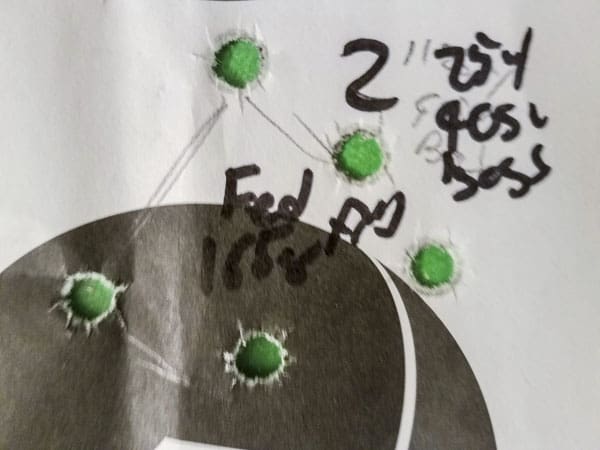
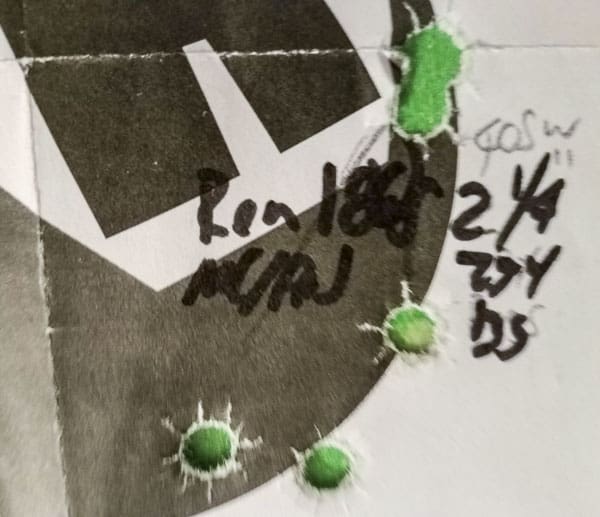
Accuracy for this .40S&W varied significantly between loadings. Shot in five shot groups off of bags at 25 yards, my best groups were with the Federal 165gr FMJs at two inches, and the worst were the Federal HydraShock 180gr HP’s at three inches. Every other type of round fired landed somewhere in between those. Not bad at all and better than most service designed guns I’ve seen.

The Baby Deagle’s is a fast gun. That doesn’t entirely surprise me, given the CZ 75 behind it. Even so, this gun doesn’t have the snappy muzzle rise so many complain about when shooting a fo-tay. Like the Beretta 92FS, the recoil is much more back and fourth than it is up and down, with little muzzle rise. It was easy to keep the front sight on target, and controlled pairs were a breeze with the gun.
At the range, I spent the first 250 rounds or so working a break-down drill. Two shots to an eight-inch circle center, one shot to each four-inch circle hip, one shot to the four-inch circle head. It was this drill that first started to pique my interest in this gun.
The first two shots were very quick, and the singles in transition were surprisingly easy. I did a half-assed Bill Wilson 5X5 Skills Test with the Baby Deagle, drawing from my pocket and also doing five shots left-handed. I scored 35.27. I only did the test twice, and that’s fast for me with a DA/SA gun I’m not used to and without a holster. On this gun, that first double action pull really slowed me down. After that, the rest of the string was brisk.
I did what has become an obligatory drill as well, which I have informally named “fall on your old broken ass, grab your gun and shoot everything you’ve got.” That’s not a bad drill for a review, because it gets the gun in the dirt and gets me shooting one-handed in an awkward position. There’s nothing spectacular about these sights, but they are bright enough and obvious enough to get a good picture, and that grip really is great even one handed. Held out at an odd angle, getting fast silhouette magazine dumps from the ground at 10 yards wasn’t much of a challenge.
It wasn’t until after I had finished shooting the Baby Desert Eagle that I looked up its MSRP…and was very pleasantly surprised. $646 is a good value for a .40S&W with all that this gun offers.
Specifications: Baby Desert Eagle III Polymer Frame
Caliber: .40S&W
Slide: Black oxide finished steel
Frame: Black polymer with accessory rail
Height: 5.75″
Weight: 28 oz.
Length: 8.375″
Slide Width: 1.25″
Barrel: 4.43” barrel
Trigger: DA/SA
Safety: Slide mounted ambidextrous with decocker
Sights: Fixed 3-dot
Magazine Capacity: 10 (two included)
MSRP: $646
Ratings (out of five stars):
Style and Customization * * *
It’s at least interesting. Although there are no rough tool marks, there’s also nothing special about the finish. Serious points off for pretty much the entire right side of the gun being covered in lettering. There isn’t much customization to be done here. You can hang whatever you want off the particularly long accessory rail, and drift out and swap the sights. That’s about it.
Accuracy * * * *
Two- and three- inches isn’t bad at all, especially not at this price point.
Reliability * * * * *
Zero issues of any kind in 500 rounds of mixed ammo. And it spent a good amount of time in the dirt.
Overall * * * *
I started this review with the notion that the Baby Deagle — especially in this caliber — was just a gimmick. Very much a why-does-this-even-exist gun. But I came away shooting a fast, fairly accurate, easy-to-handle .40S&W, and with a very different attitude. I don’t like the stacking on the DA trigger and I abhor that safety. But the Baby Desert Eagle III is otherwise a very worthy handgun.




If it doesn’t have a rotating bolt, it’s not a Desert Eagle.
IMI makes the worst CZ75 clones. I mean they work and all . . . but geez they are ugly . . . and that stupid slide mounted safety. Will manufacturers please just give up on the slide mounted safety already? It sucks to use, it sucks even more to work on . . . geez I hate that type of safety.
I love CZ’s, I can’t even bring myself to dislike the IMI version, I hate it.
You must remember that the first Jericho or Baby Eagle Generations were built by Tanfagoilo in Italy to IMI specs. Which was using what was available to the CZ clone market the slide mount safety. When IMI started to expand the line the frame mount safeties became an option.
I got a first Gen Baby Eagle and a CZ75 pre-b series pistol. Both have their pluses and minuses. But that Baby eagle is damn accurate and can take 75B mags.
I know the history of the slide mounted safety. What I don’t understand is why the slide mounted safety is not in the dustbin of history yet.
Coffee snort laugh.
Simple answer is “decocker”. Back when the Jericho was developed, slide-mounted safety/decockers were the hotness. But in this particular case, Kahr doesn’t have that excuse, because this gun isn’t even related to the Jericho.
Baby Desert Eagle.
Baby Deagle.
Beagle?
N i c e .
Are all of those sharp corners just “design”? Most manufacturers are making an attempt at edges and corners that at least won’t scar your holster and at most are “carry melt”.
Even the Beagle’s distant cousin, the CZ-P07 upgraded to a more holsterable forging and finishing in “Mark II” configuration as compared to the “Duty” forerunner.
They should have named this thing “Killer Rabbit of Caerbannog” – nasty, big, pointy teeth.
Meh. There are so many good .40 pistols out there…
But .50? .357? .44? Maybe even a 10mm? If I want a Desert Eagle of some sort, those are what I’m looking for.
Not a lot to grip onto to rack it other than the safety levers, which appear to cover up the only textured portion.
A guy has to work overtime to make a pistol really ugly.
Someone gave up a lot of weekends on this one.
Many hands make light work.
I bought an new Baby Eagle back in 2007. The thing was everything I was looking for at the time. A great shooting .45. The problem was I could not get through a magazine without some sort of malfunction. I tried a few different mags. I messed with a few things and never could get it to run right. It was really accurate, but that slide mounted safety sucked. With that, and the malfunction issue, I got rid of it. Now I have mostly CZs. No issues with any of them. I also have an Israeli police used and abused Hi Power. I swapped the springs and bought new mec gar 15 round mags. Damn that’s a great pistol!
BANG! Lol
I love the High Power—damn fine pistol in virtually every catagory.
I’d like to hear more about you racking a slide with your teeth…!
The author’s theories about this pistol’s origin are a bit misleading. The difference is not “it has a plastic frame and a slide safety”. Original Jerichos had those, too.
The BDE and BDE II were made by IMI / IWI, and were custom-branded Jerichos. The BDEs have no significant changes from the military models, and are not an evolution of the Jericho. (FWIW, I like the IMI version of the plastic Jericho better due to the lack of finger swells.)
The BDE III is made by BUL Transmark in Israel, just like the Desert Eagle 1911. The plastic framed version of the BDE III is an updated BUL Cherokee Gen2. The steel-framed version is based off the BUL Storm. The Cherokee Gen2 is based off the Tanfoglio Force (which BUL manufactured under license as the Cherokee Gen1), and the Storm is simply a Tanfoglio TA-90 copy (also manufactured under license). The guns were not derived from the Jericho, but would be first cousins in the family tree.
I’m not saying this to bash Kahr, because, really, the BUL guns are pretty great. But the decision to move the safety to the slide was entirely Kahr’s, which is pretty much inexplicable given the US market’s preference for frame safeties. I’m not even aware of a previous BUL gun with a slide safety, probably because BUL is a company of shooters, and they know slide safety/decockers suck.
what a turd
I have a steel frame Baby Eagle that I bought in 2000. The 9mm has been very reliable. The only malfunctions of any sort was due to my reloads. As far as the authors comments, I love the looks. The mix of angles and curves is reminiscent of my favorite muscle cars. Maybe the author drives a 1999 Ford Taurus and likes all curves. Then there is the slide safety. I like it. The safety gives something to grab onto. I have never had the safety to move from position while I racked the slide, but I have never had to rely on my gun for my life. Never racked a slide with my teeth either (ouch). I want my gun to have a safety, and I don’t consider the Glock safe action pistol to have a safety. The safety is easy to reach and has the great decocker with it. Personally I prefer the name Jericho (which is bad ass) over the name Baby Eagle. The Jericho has the frame safety. The slide is very narrow and nothing to grip. I have not bought a Jericho for that reason alone. Maybe racking with my teeth would be better option.
I just purchased another MRI Baby Eagle in 45 with the rail. Steel frame. I purchased it because of my experience in reliability AND the slide safety. “Baby” is not imprinted on the side of the gun. Unfortunately that is the monicker that a very fine gun is stuck with. Come on MRI you couldn’t have called it the desert hawk? Hawks are smaller than eagles, but don’t sound like a chick gun ( see what I did there, lol).
My point is, don’t let the author persuade you against a great gun. Especially for the reason that it has a useful safety.
That’s was ur accuracy from 25 yards with a full size bde3??? Terrible we shoot and hit better than u 50 yards out very accurate gun
Don’t believe everything you read in the comments. Bought a baby desert eagle 3 in steel 3 months ago. 1000 rounds later, no problems at all. Great gun !
Curiously Herman Goring https://salonpricelists.com/
was carrying one of these when he surrendered to American troops in All the highly embellished firearms he’s normally
I purchased a steel-framed Baby Eagle in 2000. The 9mm has shown to be extremely dependable. My reloads were the only source of any issues. In terms of the author’s comments, I like the looks. The combination of angles and curves reminds me of my favorite muscle cars. Perhaps the author has a 1999 Ford Taurus and enjoys all curves.